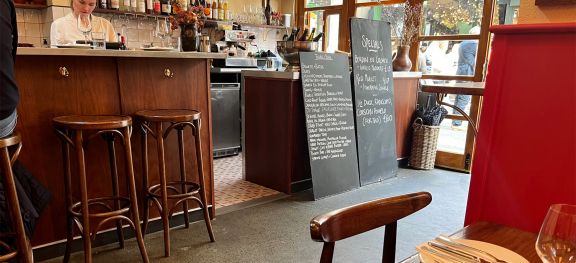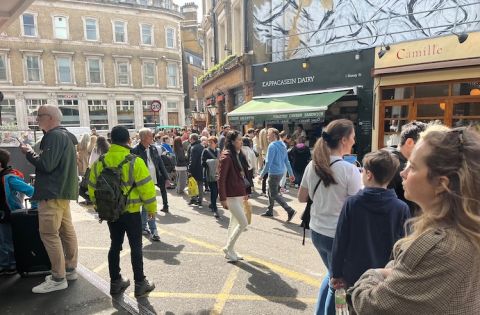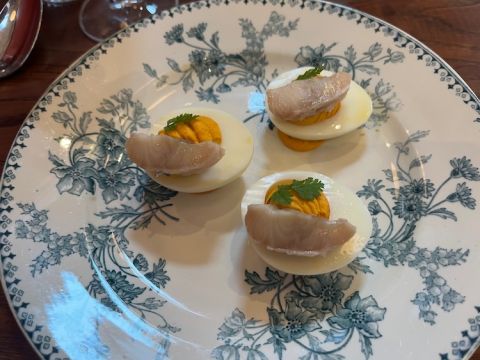Camille (v Le Cocochine)

Of two new London restaurants, Nick chooses to review the bargain option. Above, the interior of Camille.
The recent opening of two restaurants in London only serves to underscore the importance of a key factor in the launch of any new restaurant. Something which in this instance both enterprises appear to have accomplished successfully.
The first is The Cocochine in Mayfair’s discreet Bruton Place, where the head chef is Larry Jayasekara, formerly at Pétrus and The Waterside Inn, backed by Tim Jefferies, founder of the nearby Hamiltons Gallery. Here the three-course menu is £145 per person – and I suspect that there is no shortage of ‘add-ons’ to ensure nobody feels a twinge of hunger when they leave.
The second is the opening of Camille in Stoney Street on the outskirts of London’s bustling Borough Market, a fourth restaurant from Clare Lattin whose previous two London openings are Ducksoup in Soho and Little Duck/The Picklery in Dalston, East London, while the third, Emilia, is in Ashburton, Devon.
These four have been opened for a fraction of what The Cocochine has cost but both Camille and The Cocochine serve to underline a fundamental principle of the unquantifiable art of opening a restaurant. As well as organising the kitchen to cook extremely well and training waiting staff to ‘love’ their customers while they are in the restaurant, any restaurateur must ensure that what is inside the restaurant’s front door matches what is outside.
I am sure that The Cocochine’s interior matches the elegance of the cobbled street that is Bruton Place, long home to Umu restaurant and even longer to Guinea Grill as well as Bellamy’s, with even more restaurants planned for this narrow street.
By contrast, it is easier to walk past Camille than to notice it. Its entrance is partly blocked by the queue of people waiting patiently to place their order for a toasted cheese sandwich at the Kappacasein Dairy which is immediately to its left. Camille’s double-fronted exterior is comprised of many small rectangular window frames and seems slightly set back as though not wanting to attract any attention. But do persevere; it is well worth it.
Especially if you are in any way a Francophile as the interior might transport you across the Channel. There is a bar immediately on your right once you have walked in, with two blackboards, one with the day’s menu, the other with that day’s specials. On my visit the boudin en croûte, red mullet with a fisherman’s sauce and half a roast duck with radicchio and Corsican pomelo for two all tempted me.
On the bar an ice bucket is stuffed with wine bottles. The tables and chairs are in the standard brown wood and set as close together as in Vantre in Paris’s 11th arrondissement and off past the bar is the kitchen which, while not completely open, does allow occasional glimpses of several young women working very hard.
Prices at Camille seem relatively low, something that’s possible because Lattin’s investment has been under £100,000. Camille has long been a restaurant and the kitchen was in good shape when she arrived, Lattin later explained in an email. The tiles in the restaurant’s only lavatory appear to be original, too.
I was welcomed by a bevy of young women and sat down while waiting for my guest. Once he arrived then so too did three pieces of paper: a menu complete with desserts; another with aperitifs, wines by the glass and 10 ‘digestifs’ including four from Laurent Cazottes, the highly regarded artisanal producer in the Tarn; and a wine list cramming over 80 wines on its two pages thanks to a very small font size.
The menu is fascinating. It begins gently with baguette and butter, olives and Carlingford oysters before letting rip. There follows cured pig cheek and walnut; smoked eel devilled eggs; and a dish of snails and nettles. This was the first, but not the last, sign that the chef, Iranian-born Elliot Hashtroudi, had been sous chef at St John.
The next section of the menu, which we interpreted as the first courses, is relatively tame, starting with purple sprouting broccoli and yeast, including ox tongue with sparassis (cauliflower mushroom) and ending with crab toast, wild garlic and bisque. There are five main courses; a dish described as a potato pavé, an approximation of the Quality Chop House’s confit potato; and four desserts that include an ice cream made from Rollright cheese, their own canelés with prune, and burnt milk tart.
By 1 pm Camille was full and noisy because there is nothing in the room to absorb any sound. The entire wall that incorporates the bar and kitchen is lined with shelves which hold bottles of alcohol in every crevice. We were keenly aware of a table of five noisy men. However it is still possible to converse because the tables are small and close together.
I had my eye on the Normandy tripe (£25 and shown above) from the moment I sat down, my fondness for this dish accentuated by 10 days in California where there was no sign of offal on any menu anywhere. With this I ordered the devilled eggs (£9), served on plates that are often seen around London at the moment.
My old friend, whose wedding party was in my restaurant in 1982, he recalled, ordered the ox tongue (delicious, he says, for £16) and the shallot tatin with a salad of chicory, pear and Pevensey blue cheese (£23) which he finished without offering me a taste – too good to share was his feeble explanation.
My tripe dish was unctuous, replete with cubes of bacon, and would have satisfied anybody who had done a considerably harder morning’s work than me.
There was just room for a shared dessert and I was intrigued by the burnt milk tart (£9), a dish I long associate with a wonderful cook now living in South Africa. But what arrived was different and, I have to admit, even better. The excellent, thin pastry was topped by the burnt milk which had been carefully brûléed on the top. It was magnificent.
I thought I would press my luck when I was in email contact with Hashtroudi and ask him for the recipe. Back came this very honest reply: ‘The burnt milk tart is a nod to a creme brûlée. I wanted something that was reminiscent but not too on the nose. It’s custard-based and caramelised, so there’s similarity there. Booze plays a big part in the tart, as it does in a lot of my cooking. It’s a celebration of custard, one of life’s simple beauties. Sadly the burnt milk tart recipe will go to the grave with me.’
We drank three glasses of Braucol (aka Fer Servadou) from Plageoles in Gaillac (£11 a glass) from a fairly ‘natural’ wine list. With a couple of coffees I happily paid a bill of £137.29 for two, less than the cost of the food for one at The Cocochine. But that is three and a half miles away and in Mayfair, which could be in another city.
Camille 2–3 Stoney Street, London SE1 9AA; tel +44 (0)203 794 8958
Le Cocochine 27 Bruton Place, London W1J 6NQ; tel +44 (0)203 835 3957
Every Saturday, Nick writes about restaurants. To stay abreast of his reviews, sign up for our weekly newsletter.
Become a member to view this article and thousands more!
- 15,409 featured articles
- 275,057 wine reviews
- Maps from The World Atlas of Wine, 8th edition (RRP £50)
- The Oxford Companion to Wine, 5th edition (RRP £50)
- Members’ forum
- 15,409 featured articles
- 275,057 wine reviews
- Maps from The World Atlas of Wine, 8th edition (RRP £50)
- The Oxford Companion to Wine, 5th edition (RRP £50)
- Members’ forum
- 48-hour preview of all scheduled articles
- Commercial use of our wine reviews





